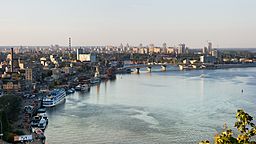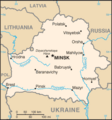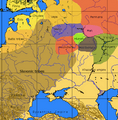Dnieper River facts for kids
Quick facts for kids Dnieper |
|
| Ukrainian: Дніпро (Dnipro) Belarusian: Дняпро (Dniapro) Russian: Днепр (Dnieper) |
|
| River | |
| Countries | Russia, Belarus, Ukraine |
|---|---|
| Tributaries | |
| - left | Sozh, Desna, Trubizh, Supiy, Sula, Psel, Vorskla, Samara, Konka, Bilozerka |
| - right | Drut, Berezina, Prypiat, Teteriv, Irpin, Stuhna, Ros, Tiasmyn, Bazavluk, Inhulets |
| Cities | Dorogobuzh, Smolensk, Mahilyow, Kyiv, Cherkasy, Dnipropetrovsk |
| Source | Glaciers |
| - location | Valdai Hills, Russia |
| Mouth | Dnieper Delta |
| Length | 2,290 km (1,423 mi) |
| Basin | 516,300 km² (199,345 sq mi) |
| Discharge | for Kherson |
| - average | 1,670 m³/s (58,975 cu ft/s) |
The Dnieper River is one of the longest and most important rivers in Europe. It starts in Russia, then flows through Belarus and Ukraine, finally emptying into the Black Sea. It is the fourth longest river in Europe.
The Dnieper is about 2,285 kilometres (1,420 mi) long. About 485 km (301 mi) of it is in Russia. Another 595 km (370 mi) flows through Belarus. The longest part, about 1,095 km (680 mi), is in Ukraine. The area of land that drains into the Dnieper is huge, covering 504,000 square kilometres (195,000 sq mi). Of this, 289,000 km2 (112,000 sq mi) is in Ukraine.
Long ago, the ancient Greeks called this river the Borysthenes. The Dnieper River is also home to the Quagga mussel, a type of freshwater clam.
Images for kids
-
The Dnieper River in Kyiv, Ukraine
-
The Dnieper River in Dorogobuzh, Russian Empire, before 1917
-
Catherine II leaving Kaniów in 1787 by Johann Gottlieb Plersch
-
Dnieper by Arkhip Kuindzhi, 1881
-
Moonlit Night on the Dnieper by Arkhip Kuindzhi, 1882
-
Ice in the Dnieper by Ivan Aivazovsky, 1872
See also
 In Spanish: Dniéper para niños
In Spanish: Dniéper para niños

















